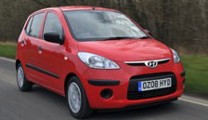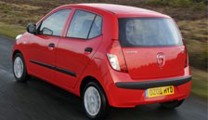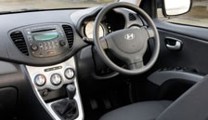Review
Anybody remember the Amica? It really was an eminently forgettable little car that underlined all of Hyundai’s shortcomings, seemingly built with no passion or sophistication.
But things are on the move at Hyundai.
The basic foundations of solid, dependable cars have always been there, but now there is a little bit of brio added into the mix.
The Santa Fe is a fine SUV, and the recent i30 is appealing, too.
Now that extra confidence has been transmitted to the Amica replacement, the i10, which is a cute little thing with plenty going for it.
So much so, that Hyundai reckons that the i10 can double its sales in the sector to 10,000 a year.
How will it do this?
By sticking to the key elements of a successful city car: cute looks, zippy handling, low price and a good deal.
The i10 is priced from £6,495, which certainly stands up to scrutiny against the competition.
On sale next month, it ticks the boxes as a financial proposition for young and old retail drivers, and those wanting a second or third car, but is unlikely to make much of a mark on the corporate market.
According to John Mahoney, Hyundai Motor UK’s corporate operations manager, the firm is not expecting many of those 10,000 to find their way into fleets, although no doubt some will go the way of Motability, especially in automatic transmission form.
There will be some limited rental exposure, however. What certainly will not happen, Mr Mahoney says, is the i10 becoming a bodyshop replacement car.
Perhaps some public sector fleets, especially in urban areas, should have a look at the i10, because although it’s a city car rather than a supermini, it has useful interior space and luggage capacity.
There’s only one choice of engine – a 1.1-litre petrol unit – which can’t be said to be a class leader in terms of environmental performance, but does just enough to make it acceptable by sneaking in below the magic 120g/km of CO2 barrier at 119g/km.
It returns 56.5mpg on the official combined cycle which makes the i10 frugal and better than the Kia Picanto, but it is not outstanding in the context of the sector.
However, it has the advantage of the 100% discount from the congestion charge from October should London mayoral candidate Boris Johnson not usurp current incumbent Ken Livingstone, and qualifies for the 10% benefit-in-kind bracket, which means a 20% taxpayer would pay £10 a month in tax for the entry-level model.
The i10 is well specified for its sub-£7,000 price with four airbags, front electric windows, power steering, central locking and a CD player with MP3 compatibility.
All trim levels also have Hyundai’s five-year unlimited mileage warranty as standard.
The mid-range Comfort trim adds such luxuries as rear electric windows, remote central locking and 14-inch alloy wheels, while at the top of the range the Style wallows in such features as rear spoiler, 15-inch alloy wheels, heated front seats and an electric sunroof.
The price for such largesse? £7,595 – which makes it a seriously good value package. An automatic gearbox option costs a further £800.
Predicted residual values look healthy, too. CAP reckons that the entry-level model will hold on to nearly 40% of its value after three years and an admittedly unrepresentative 60,000 miles.
This is a few points better than the Toyota Aygo, Citroën C1 and Peugeot 107, quite a bit better than the Picanto, while the evergreen Ford Ka is predicted to retain 24% – working out an amazing £900 less than the Hyundai even considering the small numbers involved in cost with these cars.
As for appeal to that all-important youthful first car market, the i10 is the first Hyundai city car not to look like it harks from the myopic school of car design, with some chunky, four-square looks.
It may not have the modernist lines of the Aygo/C1/107 clan or even the ageing Ka, but it’s a cheeky little thing, in which Hyundai, rightly at last, has confidence of its success.
Behind the wheel
The longest wheelbase in the sector, disc brakes all round and electric power steering all point to a decent driving experience and this is what the i10 delivers, swivelling through corners, stopping keenly and with a comfortable ride for this type of car.
Although the engine produces only 66bhp, it is zippy enough with a pleasingly snappy manual gearbox.
The automatic box produces a noisy, whiny drive.
That long wheelbase also delivers good interior space, with even a tall driver able to be comfortable and still give rear-seat passengers acceptable legroom.
One of the i10’s real strengths is its decent-sized boot – it has a 258-litre capacity with the seats up.
That’s a tremendous achievement over the letterbox efforts of the rest of the class, and could make quite a difference for somebody like a health worker looking to carry medical cases around with them.
Materials in the cabin are acceptable and well screwed together without being high on the aesthetic scale.
The dash is more traditionally laid out than some of the competition, but it is clearly organised and doesn’t feel as though it was done on a tight budget.
Verdict
Hyundai has at last produced a city car that has some wit and character.
It drives well, is keenly priced and has low running costs.
Due to its badge and rivals it is highly unlikely to ever become the volume leader in the sector, but it is certainly up there among the best in terms of sophistication, style and value.



















